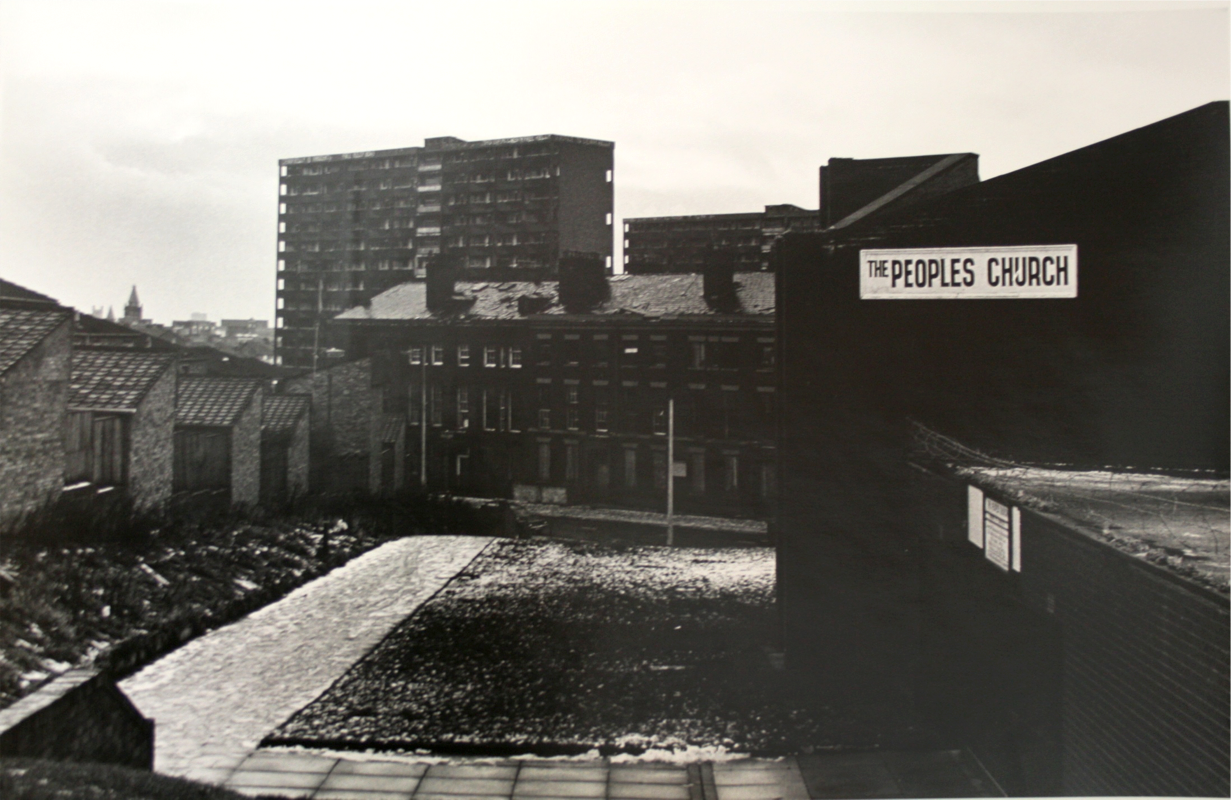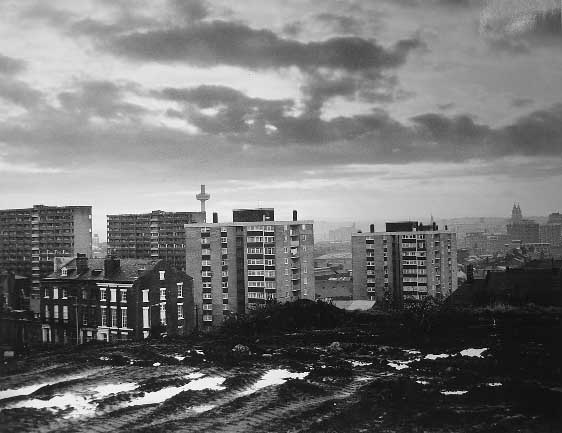


High-Rise Sties: Reflections on the Piggeries
Dan Warner is a 3rd year PhD Researcher and Teacher at the University of Liverpool. Having completed a B.A. in History and an M.A. in Cultural History, his thesis utilises social documentary photography to explore working class culture in British inner cities during the 1970s. Dan completed a placement at Open Eye Gallery in 2015, composing and delivering the Spoken Words and Photographs event during which images from the Gallery’s archive were matched with local oral histories. In the following series of blogs, Dan explores the research conducted, including representations of life in British inner cities at the time and the uses of urban street photography as an historical source. In this blog, Dan explores how John’s photography highlights how local children and adolescents made the most of a rapidly changing and decaying landscape.
—
Ominous and forebodingly present in many of John and Vanley’s shots are a collection of three identical blocks on Shaw Street. Crosbie, Canterbury and Haigh Heights in their original guise, though almost universally known as “the Piggeries”, were built in 1966. Each fifteen-storey block was promoted for the use of families and for many provided the first experience of indoor toilets and hot running water. Built from large, pre-cast concrete panels that were bolted together on site, the resulting design was hardly sensitive to the needs of its tenants and landscaping, decoration and architectural refinement was kept to a bare minimum. By the mid-1970s they had become so severely run down that tenants Mr and Mrs Irwin went on a rent strike that would eventually reach the House of Lords. Lord Denning, a judge who ruled on the case, could barely contain his shock upon visiting in 1977, just a few years before Vanley and John would take their photographs. His testimony chimes perfectly with their shots.
“At one time Everton was a slum. The houses were said to be unfit for human habitation. So the city council demolished them and built three tower blocks instead. But within 18 months the conditions there became so bad that, by all accounts, these tower blocks were not fit for human habitation.
First, the lifts were continually out of action. Either one or other of them, and sometimes both of them together. They are permanently vandalized, with buttons ripped off operating panels and lights smashed. They are regularly used as public conveniences. When the lifts are not working, people have to go up or down the staircase; but vandals constantly take out the electric light bulbs so that the staircase is very dark.
I myself travelled to the ninth floor by lift. Half an hour later no lift was operating and I had to return by staircase: throughout the whole of its length there was no light. It was still daylight outside, but down the stairs it was very dark. I heaved a very great sigh of relief when I finally did reach the ground level. How on earth a woman with two or three small children and possibly laden with shopping baskets could be expected to negotiate those stairs with any degree of peace of mind baffles me: and it is not to be forgotten that these premises are provided for the use, not of single persons or of married couples without children, but they are family houses.”[1]
Denning’s description is merely the tip of an iceberg. The rubbish chute was only 18 square inches wide, yet impressively one tenant had managed to get a mattress down there – an achievement that blocked the chute for everybody else in the meantime. Worst of all, the sewerage and sanitation system was severely faulty and the toilets regularly overflowed onto the surrounding floor or, if you were unlucky enough, into the flat below. This photograph, a Harry Ainscough print taken during the late 1960s provides something of a contrast. And its here, in these better times, that Canterbury Heights provided Eddie and his family with a childhood home between 1966 and 1968.
The vitality of Eddie’s memories contrast sharply with Vanley and John’s shots. Relocated to Huyton in 1964, the family jumped at the opportunity to move back into the old community.
“My dad wanted to be in amongst his mates. My mam went along with that; I think she was happy to move back because it was a long haul up to Huyton. Thinking about it now we should have stayed there but for some mad reason they took this flat in Canterbury Heights as an alternative to a three-bedroom house. Looking back now it was fun, but it was hard as well. You had to be tough to survive. The stairwell was full of shit and piss and you had to walk up and down it regular because the lifts never worked. It was alright for us kids; we’d have a laugh. But not for the ‘ald ones. It was a hovel. Looking back now I wonder how the hell we survived. But people lived in them. The community was great.”
This idea that the blocks were once a community was strong in Eddie’s memory.
“There was a big playground between Canterbury and Crosbie. On summer evenings the whole neighbourhood would be out. The kids would play there and all the mams and dads would be looking out over the balconies. They’d be watching the kids while chilling on the balcony. We’d have great fun.”
As well as the communal playground, the flats created new, more unorthodox, spaces of play for local children.
“The kids used to play on the landings and in the stairwells all the time. It was dangerous when you think about it. I was too busy studying for my Eleven-Plus but my younger brothers used to go up to the roof of the building through a lift shaft. Now, there’s a small ledge here and eternity on the other side. Me mam’s since said, “Christ! If I’d have known that at the time I would have collapsed!” It could have been so easy. The kids would do mad things like walk across the little ledge. There were some dangerous kids there.”
Eddie’s memories of these games of brinksmanship perhaps illustrate why Lord Denning would deem the blocks as totally unsuitable for families.
[1] Lord Denning, [1977] AC 239

